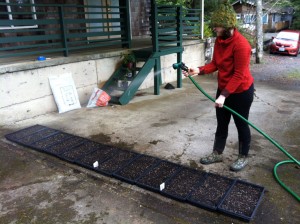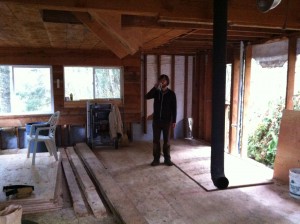 Things are finally getting rolling at the farm. Today, Emily seeded up all the flats of onions for this year. Yeah, yeah, I know- we’re a few weeks behind. Things have been crazy! We have some tasty varieties we’re planting this year, including a return visit from Fukugawa green onions, Cortland storage onions, and my beloved Ailsa Craig onions (a sweet onion, like Walla Walla, but an heirloom from Scotland that is well adapted to our weather). We’re also trying a new red onion this year, Apache. I hope it does better than the ciprollinis last year- they were tasty, but didn’t grow very large. I think they were unhappy.
Things are finally getting rolling at the farm. Today, Emily seeded up all the flats of onions for this year. Yeah, yeah, I know- we’re a few weeks behind. Things have been crazy! We have some tasty varieties we’re planting this year, including a return visit from Fukugawa green onions, Cortland storage onions, and my beloved Ailsa Craig onions (a sweet onion, like Walla Walla, but an heirloom from Scotland that is well adapted to our weather). We’re also trying a new red onion this year, Apache. I hope it does better than the ciprollinis last year- they were tasty, but didn’t grow very large. I think they were unhappy.

The work on the cabin continues apace. Adam really stuck it out, and when all was said and done, he put in over 30 hours of work with me last week. We got a huge milestone out of the way, too: the jacking of the house, and subsequent new subflooring, is complete. Here we see Adam in our moment of victory on the new, sturdy plywood floor. We celebrated on the last day by dragging the wood stove back to its original position, and provisionally hooking it up to the chimney once again. By the time Emily showed up with the celebratory pizza, we had a roaring fire going and… well… had the first pizza party of the new house. Yay!
But what I’m really excited to talk about today is the WaterMaster. His job, along with his four counterparts in Oregon, is to make sure everyone gets their fair share of our limited groundwater supply (1). He measures river flows, reservoir levels, and so forth, looks at recorded water rights, and tells users when they have to ration or are completely cut off during the dry season. He is also knowledgeable about the geology and hydrology of the state, and can make insightful recommendations about groundwater practices.
As part of getting a building permit, the county required me to get a letter from him stating that it was theoretically possible to get water on the site. After several weeks of trying to coordinate schedules (remember, there are only five watermasters in the whole state), he offered to meet me at the property. Needless to say, I was thrilled- a chance to get more quality advice from a knowledgeable person.
When he arrived, we walked around the property and looked at the options. Some things I already knew, or at least suspected: the creek is for all practical purposes useless to us. Users with much older water rights have priority, and during the months we’d need water for irrigation, the reduced summer flow of the creek wouldn’t even be enough to satisfy their demands, and we’d be legally prohibited from using it.
He also brought with him a list of wells on nearby properties (all wells must be recorded with his office). The news was bleak: most were between 150 and 210 feet deep, and produced little flow. One well didn’t produce anything. Our neighbor told me a few months ago that he had a 200-foot well that had water so iron-laden that it turned his wife’s hair orange. She got mad about that, and had him dig a “surface well.” It then produced copious amounts of sparkling, tasty water.
Now, I’d heard about this “surface well” before, from both the farmer across the street, as well as my excavator buddy that redid the driveway. It sounded a little sketchy, but very interesting, so I got excited when the watermaster started talking about it. “Your property is a great opportunity for a surface well,” he explained, starting in with a geology lesson. It seems that most of the soils of oregon are build up of a very deep clay-sandstone plate that was once ocean bottom. Tectonic activity pushed it up into the Cascadia range, after which it became covered with gravel as things broke down, and eventually organic matter formed. End result: groundwater flows like an underground river, above the clay plate, through the gravel.
That’s where the “surface well” comes in. If you dig through the plate, you get no water or bad water, as the good and plentiful stuff is held above the clay layer. But a much of the rainwater we get is constantly collecting underground in the shallow, gravelly layer above the clay plate. The surface well exploits this hydrology. It’s a ±5 foot diameter vertical concrete pipe, about 12 feet deep, with perforations along the lower half of it. It’s placed in a 12′ wide pit that’s filled with coarse gravel, that allows the subsurface water to percolate through and into the pipe. At the water table, the coarse gravel is capped with geotextile fabric and a layer of bentonite clay, then the rest of the pit is backfilled. Bentonite expands upon contact with water, forming a seal to keep potentially contaminated water from the ACTUAL surface out of the well.
Of course, there are some catches. The big one is that the surface well is only allowed if it’s constructed by the property owner. Weird. I guess it’s a holdback to frontier days and American notions of self-sufficiency, much like the same rules that make it OK for a property owner to do his own plumbing and electrical work without a plumber’s or electrician’s license. I’m not so hot on digging a 12′ by 12′ hole, but not to worry: I’m allowed to pay someone to do that, as long as I am the main contractor and direct the work, and the guy was on my property to do other work anyway. I also am required to get the construction bond, pay for the permits, and so forth.
This… is getting to be more of an adventure every day!
(1) Side rant: yes, even at 96″ of annual rainfall, we have a limited supply of water. In fact, everyone does. The potable water on this planet is limited, aquifers are being depleted by irresponsible irrigation, and more than half of drinkable water used in buildings is flushed down the toilet.

